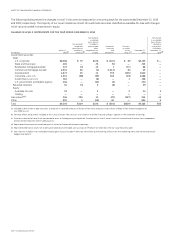GE 2010 Annual Report Download - page 122
Download and view the complete annual report
Please find page 122 of the 2010 GE annual report below. You can navigate through the pages in the report by either clicking on the pages listed below, or by using the keyword search tool below to find specific information within the annual report.
120 GE 2010 ANNUAL REPORT
IMPAIRED LOANS
The vast majority of our Consumer nonaccrual financing receiv-
ables are smaller-balance homogeneous loans evaluated
collectively, by portfolio, for impairment and therefore are outside
the scope of the disclosure requirement for impaired loans.
Accordingly, impaired loans in our Consumer business represent
restructured smaller-balance homogeneous loans meeting the
definition of a TDR, and therefore subject to the disclosure
requirement for impaired loans, and commercial loans in our
Consumer—Other portfolio. The recorded investment of these
impaired loans totaled $2,554 million (with an unpaid principal
balance of $2,244 million) and comprised $106 million with no
specific allowance, primarily all in our Consumer—Other portfolio,
and $2,448 million with a specific allowance of $555 million at
December 31, 2010. The impaired loans with a specific allowance
included $428 million with a specific allowance of $114 million in
our Consumer—Other portfolio and $2,020 million with a specific
allowance of $441 million across the remaining Consumer busi-
ness and had an unpaid principal balance and average investment
of $2,139 million and $1,771 million, respectively, at December 31,
2010. We recognized $115 million of interest income for the year
ended December 31, 2010, principally on a cash basis. A substan-
tial majority of this amount related to income recognized in our
Consumer—U.S. installment and revolving credit business.
CREDIT QUALITY INDICATORS
Our Consumer financing receivables portfolio comprises both
secured and unsecured lending. Secured financing receivables
comprise residential loans and lending to small and medium-
sized enterprises predominantly secured by auto and equipment,
inventory finance, and cash flow loans. Unsecured financing
receivables include private-label credit card financing. A substan-
tial majority of these cards are not for general use and are limited
to the products and services sold by the retailer. The private-label
portfolio is diverse, with no metropolitan area accounting for
more than 6% of the related portfolio.
FINANCING RECEIVABLES AND ALLOWANCE FOR LOSSES
The following table provides further information about general
and specific reserves related to Consumer financing receivables.
CONSUMER
(a)
Financing receivables at
December 31, January 1, December 31,
(In millions) 2010 2010
(b) 2009
Non-U.S. residential mortgages $ 45,536 $ 54,921 $ 54,921
Non-U.S. installment and
revolving credit 20,368 23,443 23,443
U.S. installment and
revolving credit 43,974 44,008 20,027
Non-U.S. auto 8,877 12,762 12,762
Other 8,306 10,156 10,156
Total Consumer financing
receivables, before allowance
for losses $127,061 $145,290 $121,309
Non-impaired
financing receivables $124,507 $143,593 $119,976
General reserves 3,984 5,488 3,952
Impaired loans 2,554 1,697 1,333
Specific reserves 555 301 235
(a) During the first quarter of 2010, we transferred the Consumer business in Italy
from Consumer to CLL. Prior-period amounts were reclassified to conform to the
current-period presentation.
(b) Reflects the effects of our adoption of ASU 2009-16 & 17 on January 1, 2010.
PAST DUE FINANCING RECEIVABLES
The following table displays payment performance of Consumer
financing receivables.
CONSUMER
2010
2009
Over 30 days Over 90 days Over 30 days Over 90 days
December 31 past due past due
(a) past due past due
(a)
Non-U.S. residential
mortgages 13.3% 8.4% 13.5% 8.3%
Non-U.S. installment
and revolving credit 4.5 1.3 5.4 1.8
U.S. installment and
revolving credit 6.2 2.8 9.0 4.3
Non-U.S. auto 3.2 0.5 3.3 0.5
Other 4.2 2.3 5.4 3.0
Total 8.1 4.4 9.4 5.1
(a) Included $268 million and $236 million of loans at December 31, 2010 and 2009,
respectively, which are over 90 days past due and accruing interest. A substantial
majority of these loans are covered by third-party mortgage insurance, which
provide for payment of principal and interest on the underlying loan.
NONACCRUAL FINANCING RECEIVABLES
The following table provides further information about Consumer financing receivables that are classified as nonaccrual.
CONSUMER(a)
Nonaccrual financing receivables at Nonearning financing receivables at
December 31, January 1, December 31, December 31, January 1, December 31,
(Dollars in millions) 2010 2010
(b) 2009 2010 2010
(b) 2009
Non-U.S. residential mortgages $4,059 $4,352 $4,352 $3,812 $4,331 $4,331
Non-U.S. installment and revolving credit 303 423 423 290 409 409
U.S. installment and revolving credit 1,201 1,624 832 1,201 1,624 832
Non-U.S. auto 48 78 78 48 66 66
Other 600 630 630 478 610 610
Total $6,211 $7,107 $6,315 $5,829 $7,040 $6,248
Allowance for losses percentage 73.1 % 81.5 % 66.3 % 77.9 % 82.2 % 67.0%
(a) During the first quarter of 2010, we transferred the Consumer business in Italy from Consumer to CLL. Prior-period amounts were reclassified to conform to the current-period presentation.
(b) Reflects the effects of our adoption of ASU 2009-16 & 17 on January 1, 2010.
























